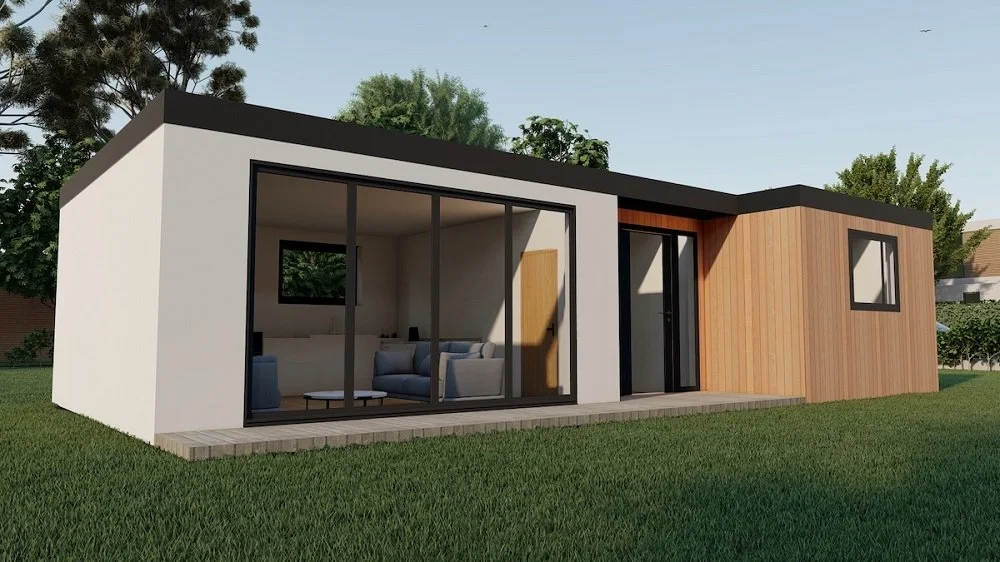Outdoor Therapy: Transforming Your Garden into a Sanctuary
/In today's fast-paced world, finding moments of peace and tranquility can be a challenge. One way to cultivate a sense of calm and rejuvenation is through spending time in nature. Transforming your garden into a sanctuary can provide you with a therapeutic outdoor space where you can relax, unwind, and connect with the natural world.
Outdoor therapy, also known as ecotherapy or horticultural therapy, is a form of mental health treatment that involves spending time in natural settings to improve overall well-being. Research has shown that spending time outdoors in the natural world -- by hiking, forest bathing, birdwatching, visiting a park or nature preserve -- can reduce stress, anxiety, and depression, as well as improve mood and cognitive function.
You can also reap the benefits of ecotherapy right in your own backyard. By creating a peaceful and inviting outdoor space, you can easily incorporate outdoor therapy into your daily routine. Whether you have a small balcony, a spacious yard, or a sprawling garden, there are many ways to transform your outdoor space into a sanctuary that promotes relaxation and mental well-being. This article shares an few ideas for creating a therapeutic garden that can help you de-stress, unwind, and rejuvenate.
Everyday Horticultural Therapy
Nurturing plants is like therapy for the soul, boosting your mood and vitality according to the majority of scientific research on this topic. Spending time in nature and engaging in gardening activities can help reduce stress, anxiety, and depression. The act of planting, nurturing, and watching plants grow can also provide a sense of accomplishment and purpose, especially if you are growing at least some food in your garden.
Gardening also offers a sense of connection to the natural world, which can be grounding and healing. It allows you to slow down, be present in the moment, and appreciate the beauty of your surroundings. The physical activity involved in gardening can also improve your physical health by reducing blood pressure, improving circulation, and boosting immune function.
Research has shown that spending time in nature can reduce stress, anxiety, negative thoughts and depression, as well as improve mood and cognitive function. Being surrounded by greenery and fresh air can help calm the mind, reduce negative thoughts, and promote a sense of relaxation and peace. When you create your own garden sancuary, you are creating a space where you can reap these benefits on a daily basis.
Creating a Garden Sanctuary in Your Backyard
A garden sanctuary is a peaceful and inviting outdoor space that is designed to promote relaxation, rejuvenation, and mental well-being. It is a place where you can escape the stresses of daily life, connect with nature, and find moments of calm and tranquility. A garden sanctuary should be a place that nurtures your senses and soothes your soul. In some cases, your existing garden can provide these benefits with a few simple additions. In other cases, you may want to begin from scratch or plan a major garden overhaul to create the tranquil and inviting space you need.
To create a garden sanctuary, start by thinking about the goals you'd like to achieve. It helps to write these down - you're more likely to get a better sense of the big picture and follow through if you do.
Establish Goals
Before you begin transforming your garden into a sanctuary, consider what aspects of your mental well-being you want to focus on improving, whether it's reducing stress, increasing relaxation, promoting mindfulness, or boosting mood.
You may also want to think about specific activities you enjoy doing outdoors that can contribute to your overall well-being, such as yoga, meditation, deep breathing exercises, reading, or simply enjoying a cup of tea in nature. By setting clear goals for your garden sanctuary, you can design a space that meets your specific needs and enhances your mental health.
Also consider the layout and design of your outdoor space before you begin. Think about how you can incorporate elements that promote relaxation, such as comfortable seating areas, soothing water features, fragrant flowers, and lush greenery. These will be the first steps to creating a space where you can relax and enjoy the natural world.
A Relaxing and Therapeutic Space
Once you have established your goals for your garden sanctuary, it's time to start creating a space that is calming, rejuvenating, and therapeutic. Here are some tips on how to design a relaxing and therapeutic outdoor space:
1. Incorporate elements of nature: Integrate natural elements such as water features, rocks, wood, and plants into your garden sanctuary to create a sense of connection to the natural world. Water features like fountains or ponds can provide soothing sounds and promote relaxation, while rocks and wood can add texture and visual interest. Plants like lavender, chamomile, and jasmine have calming properties and can help reduce stress and anxiety.
2. Create comfortable seating areas: Make sure you have plenty of seating options in your garden sanctuary where you can relax and unwind. Choose comfortable outdoor furniture like lounge chairs, hammocks, or a cozy bench where you can sit and enjoy the peaceful surroundings. Consider adding cushions, pillows, or blankets for added comfort. Be sure to locae some of these features in areas of your garden that are always shaded so you can enjoy them even when it's hot outside. Areas of your garden that are constantly shaded can make the air feel 10-15 degrees cooler than areas that get full sun for the majority of the day.
3. Add lighting for ambiance: Extend the use of your garden sanctuary into the evening by incorporating outdoor lighting. Soft string lights, lanterns, or candles can create a warm and inviting atmosphere in your outdoor space. Consider installing solar-powered lights for an eco-friendly option that doesn't require electricity. Lighting can help set the mood and create a tranquil ambiance for relaxation and meditation.
4. Include sensory elements: Engage all of your senses in your garden sanctuary by incorporating elements that appeal to sight, touch, smell, taste, and sound. Choose plants with fragrant flowers or herbs that release pleasant scents when touched, create a small herb garden for tasting fresh ingredients, install wind chimes or outdoor speakers for soothing sounds, and add colorful flowers or artwork for visual appeal. By incorporating sensory elements into your garden sanctuary, you can create a multi-dimensional experience that enhances your overall well-being.
Adding Healing Elements to Your Garden Sanctuary
Some aspects of your garden can further promote physical, emotional, and spiritual well-being through the incorporation of elements that encourage mindfulness and healing. These elements include the following:
1. Therapeutic plants: Select plants that have calming and healing properties to incorporate into your garden. Consider including herbs like lavender, chamomile, and mint, which are known for their stress-relieving and soothing effects. Other plants like aloe vera, echinacea, and calendula have healing properties that can be beneficial for physical ailments. You may want to designate a particular area of your garden as a "healing garden" filled with these kinds of plants; many hospitals in the United States mow incorporate such spaces into their landscape design.
2. Spaces for reflection: Designate areas in your garden where you can practice mindfulness, meditation, or reflection. This could be a simple shaded corner with a comfortable cushion or bench, or a peaceful spot near a water feature where you can sit and reflect. Consider adding elements like wind chimes, prayer flags, or -- if you have a bit more ambition -- a mini-Japanese zen garden with large rocks, and raked sand or gravel to enhance the calming energy of these spaces. Add fragrant plants like lavender and jasmine to your space for a calming effect.
3. Spaces for mindful movement: To further enhance the healing atmosphere in your garden sanctuary, consider adding a small space for yoga or tai chi practice. This could be a cleared area of grass or a designated platform where you can engage in gentle movements and connect with your body and breath. Adding a few yoga mats, meditation cushions, or even a small water feature can help create a serene environment for these activities. Practicing mindful movement in nature can help reduce stress, improve flexibility, and promote overall well-being.
Hardscape
Hardscape elements can also play a significant role in transforming your garden into a sanctuary. Incorporating features like pathways, patios, or decks can help define different areas of your outdoor space and create a sense of structure. Consider using natural materials like stone, brick, or wood to add texture and visual interest to your garden. Some of the hardscape elements you can incorporate intoyour outdoor therapy space include the following:
1. A Pathway: Install a meandering pathway through your garden to encourage exploration and provide a sense of direction. Use stepping stones, gravel, or pavers to create a visually appealing route that leads visitors through different areas of your garden. Consider lining the pathway with flowers, shrubs, or other plants to create a sense of cohesion and guide the eye.
2. A Patio or Deck: Create a designated seating area in your garden with a patio or deck where you can relax, read, or entertain guests. Choose comfortable outdoor furniture like chairs, benches, or hammocks to enhance the comfort and functionality of this space. Add finishing touches like cushions, throw pillows, and outdoor rugs to make the area inviting and cozy. Consider adding a pergola, umbrella, or other shade structure to provide relief from the sun during hot summer days.
3. Structural elements: Consider adding elements like a pergola, trellis, or arbor to create vertical interest and provide structure in your garden. These features can also offer shade and privacy, enhancing the peaceful ambience of your outdoor space.
Choosing Plants That Speak to You
When selecting plants for your outdoor therapy garden, consider choosing ones that have personal meaning or significance to you. Whether it's a favorite flower from your childhood or a plant that reminds you of a loved one, incorporating these meaningful plants can help create a sense of connection and comfort in your garden sanctuary.
Additionally, consider the sensory experience that certain plants can provide. Plants with fragrant flowers or leaves can engage your sense of smell and create a calming atmosphere. Consider adding herbs like lavender, rosemary, or mint for their soothing scents and ability to promote relaxation and a sense of tranquility.
Incorporating a variety of textures and colors in your plant selection can also create visual interest and stimulate different senses. Mix blooming flowers with lush green foliage, ornamental grasses, and succulents to create a diverse and dynamic garden space. Roses, in particular, are commonly found in garden sancturies, as they symbolize purity, devotion, and spiritual growth. Their distinctive scent can also evoke euphoric feelings, making them a popular choice for creating a peaceful and harmonious atmosphere. Roses are also used in aromatherapy to help treat anxiety and depression, making them ideal residents in your garden.
When creating your garden sanctuary, it's important to choose plants that are easy to care for and maintain. Opt for low-maintenance plants that require minimal watering, pruning, and fertilizing to ensure that your outdoor therapy space remains a calming retreat rather than a source of stress. Consider selecting native plants or drought-tolerant species that are well-suited to your climate and soil conditions to minimize the amount of care they require. Finally, incorporating a mix of evergreen and deciduous plants can ensure that your garden sanctuary remains visually appealing year-round.
Make Tools and Chores Work for You
When transforming your garden into a sanctuary for outdoor therapy, consider incorporating ergonomic tools to make gardening tasks more comfortable and enjoyable. Ergonomic tools are designed with the user's comfort and safety in mind, reducing strain on muscles and joints while performing repetitive tasks like digging, planting, weeding, and pruning.
Look for tools with features like padded handles, adjustable lengths, and lightweight materials to make gardening tasks easier on your body. Consider investing in tools like ergonomic trowels, pruners, and shovels to make your gardening experience more enjoyable.
Additionally, redefining the way you approach garden chores can help create a more mindful and therapeutic experience. Instead of viewing tasks like weeding or pruning as burdensome chores, try to see them as opportunities to connect with nature and practice mindfulness. Approach each task with intention and focus on the present moment, allowing yourself to fully immerse in the sights, sounds, and sensations of your garden sanctuary.
Conclusion
From incorporating calming elements like water features, meandering pathways and soothing plants to creating designated meditation areas and outdoor seating spaces, there are many different options available to you for designing a garden that promotes a sense of peacefulness and solace. By taking the time to prioritize your outdoor space and create a sanctuary for yourself, you can enjoy the benefits of outdoor therapy right at home.
Transforming your garden into a sanctuary is not only a way to beautify your outdoor space, but also a way to prioritize your mental health and well-being. By embracing the healing power of nature and creating a peaceful retreat in your own backyard, you can find moments of tranquility and rejuvenation in today's busy world.










































In much of the Northern Hemisphere, August is one of the hottest months of the year. As a result, many lawns are parched, with patches of brown and an overgrowth of hardy weeds scarring the landscape. Keeping a lawn green year-round is especially challenging this time of year; even more so if your area has seen a relentless onslaught of summer heat or drought conditions, or your city or municipality has placed restrictions on your use of water.